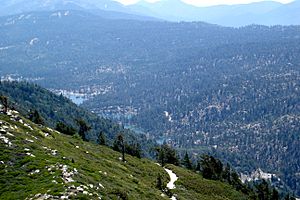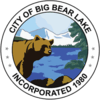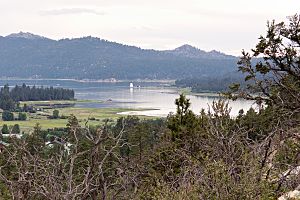Big Bear Lake, California facts for kids
Quick facts for kids
Big Bear Lake, California
|
||
|---|---|---|

Looking east at Big Bear Valley from Butler Peak lookout tower in the San Bernardino National Forest
|
||
|
||

Location of Big Bear Lake in San Bernardino County, California
|
||
| Country | United States | |
| State | California | |
| County | San Bernardino | |
| Incorporated | November 28, 1980 | |
| Government | ||
| • Type | Council/Manager | |
| Area | ||
| • Total | 6.42 sq mi (16.64 km2) | |
| • Land | 6.24 sq mi (16.16 km2) | |
| • Water | 0.18 sq mi (0.47 km2) 2.88% | |
| Elevation | 6,752 ft (2,058 m) | |
| Population
(2020)
|
||
| • Total | 5,046 | |
| • Density | 808.52/sq mi (312.17/km2) | |
| Time zone | UTC−8 (PST) | |
| • Summer (DST) | UTC−7 (PDT) | |
| ZIP Code |
92315
|
|
| Area code(s) | 909 | |
| FIPS code | 06-06434 | |
| GNIS feature ID | 1652673 | |
Big Bear Lake is a small city in San Bernardino County, California, located in the San Bernardino Mountains along the south shore of Big Bear Lake, and surrounded by the San Bernardino National Forest. The city is located about 25 miles (40 km) northeast of the city of San Bernardino, and immediately west of the unincorporated town of Big Bear City. The population was approximately 5,019 at the 2010 census, down from 5,438 at the 2000 census. However, since it is a popular year-round resort destination, the actual number of people staying in or visiting the greater Big Bear Valley area regularly surges to over 100,000 during many weekends of the year.
The California Office of Environmental Health Hazard Assessment has issued a safety advisory for any fish caught in Big Bear Lake due to elevated levels of mercury and PCBs.
Contents
History
Big Bear Lake was inhabited by the indigenous Serrano Indians for over 2,000 years before it was explored by Benjamin Wilson and his party. Once populated by only the natives and the grizzly bears, from which the area received its name, the population of the Big Bear Valley grew rapidly during the Southern California Gold Rush from 1861 to 1912. Grizzly bears were not found in the region after 1908. Today, there are black bears in the region since their introduction in 1933, and they are sometimes sighted in residential areas.
A trip to Big Bear Lake from San Bernardino took two days on horse-drawn coaches. Kirk Phillips was a local who took a trip to New York City and saw the world's first bus line. This inspired him to create the world's second bus line from San Bernardino to Big Bear Valley using White trucks with several rows of seats. This made it possible for the villages to grow and for Big Bear Lake to become the first mountain recreation area in Southern California.
Many people traveled to enjoy recreation on the lake, however, another major draw was the natural hot spring. Emile Jesserun bought 40 acres (16 ha) of land that included the hot spring and built the first major resort in Big Bear, the Pan Hot Springs Hotel, in 1921.
This resort was followed with others that strived to be the best by creating a country club atmosphere complete with the amenities required to lure the Hollywood celebrities of the time including Cecil B. DeMille, Shirley Temple, and Ginger Rogers.
It was also a popular place for shooting on location, as they did for the filming of the 1920 version of Last of the Mohicans and a number of Bonanza episodes in the 1960s at Cedar Lake. 1924 saw Big Bear populated with 44 resorts and a constant stream of vacationers. The Pan Hot Springs Hotel, like many of the other resorts and hotels in Big Bear, was extensively damaged by fire in 1933.
Big Bear Lake was one of the filming locations for Daniel Boone, Gone with the Wind, Disney's Old Yeller, the 1969 musical film Paint Your Wagon, the 1983 movie War Games, the opening to NBC's children's program HR Pufnstuf and the ending scene in Better Off Dead.
Winter activities are also popular in Big Bear. The first ski jump in Big Bear was erected in 1929 and quickly claimed a world ski jump record. More jumps were built in Big Bear Lake and the Viking Ski Club of Los Angeles began to use them for competition and events. The move to a winter resort town was solidified in 1952 when Tommy Tyndall opened a resort in Big Bear Lake now known as Snow Summit.
In the summer of 1968, Caltech began construction of Big Bear Solar Observatory (BBSO) located on the north shore of Big Bear Lake. Due to extensive rain and snow, the lake rose several feet and BBSO was surrounded by water at the time construction was completed using makeshift barges in May 1970. BBSO, now operated by the New Jersey Institute of Technology, is still a major Big Bear Lake landmark connected to the north shore by a dirt and rock causeway.
Since 1970, Big Bear Lake has held its annual Oktoberfest. The Big Bear Lake Oktoberfest also sports the highest Biergarten in the U.S. (in elevation). Big Bear Lake was incorporated as a city on November 28, 1980.
During the 1990s, the city became famous as a training spot for boxing champions. Oscar de la Hoya, Mike Tyson, Fernando Vargas, Gennady Golovkin, and Shane Mosley are among the famous boxers who have trained at Big Bear.
In February 2013, a major manhunt occurred in the Big Bear Lake area to find Christopher Dorner, who by that point had killed three people. A standoff ended in nearby Angelus Oaks.
Geography
Big Bear Lake is located at 34°14′29″N 116°54′12″W / 34.24139°N 116.90333°W (34.241295, −116.903289). According to the United States Census Bureau, the city has a total area of 6.5 square miles (17 km2). 6.3 square miles (16 km2) of it is land and 0.2 square miles (0.52 km2) of it (2.88%) is water. It is located 25 miles (40 km) northeast of the city of San Bernardino, and immediately west of Big Bear City.
Climate
According to the National Weather Service, the warmest month at Big Bear is July, with a daily average temperature of 64.7 °F (18.2 °C). The coolest month is January, with a daily average temperature of 34.1 °F (1.2 °C). There are an average of 1.7 days each year with highs of 90 °F (32 °C) or higher. Freezing temperatures have occurred in every month and occur on an average of 186 days each year, on average from September 24 to June 4. With a period of record dating back to only 1960, the highest temperature recorded was 94 °F (34 °C), last recorded on July 15, 1998, while lowest was −25 °F (−32 °C) on January 29, 1979.
Due to the 6,790 to 7,200 ft (2,070 to 2,190 m) elevation of the weather station, precipitation is greater than in the lowlands of San Bernardino County, averaging 21.15 in (537 mm) a year. The maximum 24-hour precipitation was 9.43 in (240 mm) on December 6, 1966. Measurable precipitation normally occurs 44.9 days a year. Mountain thunderstorms occasionally produce heavy rainfall, even in midsummer (when most southern California lowland locations are quite dry). Big Bear Lake's climate is Csb (Warm-summer Mediterranean) under the Köppen climate classification.
In contrast to most of southern California, the Big Bear Lake region normally receives significant winter snow because of its high elevation. Snowfall, as measured at lake level, averages 72 in (180 cm) per season; upwards of 100 in (250 cm) can accumulate on the forested ridges bordering the lake, at elevations above 8,000 ft (2,400 m). In February 1990, 59.5 in (151 cm) of snow were recorded. The most snow in 24 hours was 27.0 in (69 cm) on March 27, 1991. The greatest snow depth was 58 in (150 cm) on February 3, 1979. Snow has fallen in every month except July and August. There are normally 18 days each year with measurable snow of 0.1 in (0.25 cm) or more.
| Climate data for Big Bear Lake, California (1981–2010 normals) | |||||||||||||
|---|---|---|---|---|---|---|---|---|---|---|---|---|---|
| Month | Jan | Feb | Mar | Apr | May | Jun | Jul | Aug | Sep | Oct | Nov | Dec | Year |
| Average high °F (°C) | 47.0 (8.3) |
47.1 (8.4) |
52.1 (11.2) |
58.7 (14.8) |
68.1 (20.1) |
76.2 (24.6) |
81.2 (27.3) |
79.8 (26.6) |
74.1 (23.4) |
64.0 (17.8) |
54.4 (12.4) |
47.6 (8.7) |
62.5 (17.0) |
| Daily mean °F (°C) | 34.1 (1.2) |
34.6 (1.4) |
38.6 (3.7) |
43.9 (6.6) |
51.9 (11.1) |
59.0 (15.0) |
64.7 (18.2) |
63.6 (17.6) |
57.9 (14.4) |
48.5 (9.2) |
40.3 (4.6) |
34.5 (1.4) |
47.6 (8.7) |
| Average low °F (°C) | 21.2 (−6.0) |
22.1 (−5.5) |
25.0 (−3.9) |
29.1 (−1.6) |
35.7 (2.1) |
41.8 (5.4) |
48.2 (9.0) |
47.4 (8.6) |
41.6 (5.3) |
33.0 (0.6) |
26.2 (−3.2) |
21.3 (−5.9) |
32.7 (0.4) |
| Average precipitation inches (mm) | 4.45 (113) |
3.91 (99) |
2.66 (68) |
.95 (24) |
.35 (8.9) |
.15 (3.8) |
.67 (17) |
1.04 (26) |
.42 (11) |
.94 (24) |
1.50 (38) |
3.01 (76) |
20.05 (508.7) |
| Average snowfall inches (cm) | 16.5 (42) |
18.1 (46) |
14.7 (37) |
4.1 (10) |
.5 (1.3) |
0 (0) |
0 (0) |
0 (0) |
.1 (0.25) |
1.2 (3.0) |
4.7 (12) |
12.3 (31) |
72.3 (184) |
| Average precipitation days (≥ 0.01 in) | 6.3 | 6.3 | 5.7 | 3.7 | 1.8 | .8 | 2.6 | 3.2 | 2.2 | 2.7 | 3.1 | 5.1 | 43.5 |
| Average snowy days (≥ 0.1 in) | 3.8 | 3.8 | 3.4 | 1.5 | .3 | .1 | 0 | 0 | 0 | .4 | 1.4 | 3.3 | 18.0 |
| Source: NOAA | |||||||||||||
Demographics
| Historical population | |||
|---|---|---|---|
| Census | Pop. | %± | |
| 1990 | 5,351 | — | |
| 2000 | 5,438 | 1.6% | |
| 2010 | 5,019 | −7.7% | |
| 2020 | 5,046 | 0.5% | |
| U.S. Decennial Census | |||
2010
The 2010 United States Census reported that Big Bear Lake had a population of 5,019. The population density was 768.1 people per square mile (296.6/km2). The racial makeup of Big Bear Lake was 4,204 (83.8%) White, (73.3% Non-Hispanic White), 22 (0.4%) African American, 48 (1.0%) Native American, 78 (1.6%) Asian, 10 (0.2%) Pacific Islander, 491 (9.8%) from other races, and 166 (3.3%) from two or more races. Hispanic or Latino of any race were 1,076 persons (21.4%).
The Census reported that 4,993 people (99.5% of the population) lived in households, 5 (0.1%) lived in non-institutionalized group quarters, and 21 (0.4%) were institutionalized.
There were 2,187 households, out of which 563 (25.7%) had children under the age of 18 living in them; 1,007 (46.0%) were opposite-sex married couples living together; 195 (8.9%) had a female householder with no husband present; 119 (5.4%) had a male householder with no wife present. There were 159 (7.3%) unmarried opposite-sex partnerships, and 24 (1.1%) same-sex married couples or partnerships. 675 households (30.9%) were made up of individuals, and 298 (13.6%) had someone living alone who was 65 years of age or older. The average household size was 2.28. There were 1,321 families (60.4% of all households); the average family size was 2.83.
The population was spread out, with 993 people (19.8%) under the age of 18, 417 people (8.3%) aged 18 to 24, 1,021 people (20.3%) aged 25 to 44, 1,563 people (31.1%) aged 45 to 64, and 1,025 people (20.4%) who were 65 years of age or older. The median age was 46.1 years. For every 100 females, there were 104.7 males. For every 100 females age 18 and over, there were 103.8 males.
There were 9,705 housing units at an average density of 1,485.3 per square mile (573.5/km2), of which 1,271 (58.1%) were owner-occupied, and 916 (41.9%) were occupied by renters. The homeowner vacancy rate was 14.0%; the rental vacancy rate was 45.2%. 2,708 people (54.0% of the population) lived in owner-occupied housing units and 2,285 people (45.5%) lived in rental housing units.
According to the 2010 United States Census, Big Bear Lake had a median household income of $32,869, with 16.9% of the population living below the federal poverty line.
2000
As of the census of 2000, there were 5,438 people, 2,343 households, and 1,494 families residing in the city. The population density was 860.1 inhabitants per square mile (332.2/km2). There were 8,705 housing units at an average density of 1,376.8 per square mile (531.8/km2). The racial makeup of the city was 91.2% White, 0.7% African American, 1.0% Native American, 0.8% Asian, <0.1% Pacific Islander, 3.6% from other races, and 2.8% from two or more races. Hispanic or Latino people of any race were 13.7% of the population.
There were 2,343 households, out of which 25.3% had children under the age of 18 living with them, 51.3% were married couples living together, 8.5% had a female householder with no husband present, and 36.2% were non-families. 29.4% of all households were made up of individuals, and 10.8% had someone living alone who was 65 years of age or older. The average household size was 2.3 and the average family size was 2.8.
In the city, the population was spread out, with 22.6% under the age of 18, 6.4% from 18 to 24, 24.5% from 25 to 44, 29.1% from 45 to 64, and 17.4% who were 65 years of age or older. The median age was 43 years. For every 100 females, there were 107.1 males. For every 100 females age 18 and over, there were 103.0 males.
The median income for a household in the city was $100,447, and the median income for a family was $122,848. Males had a median income of $36,316 versus $21,404 for females. The per capita income for the city was $21,517. About 11.1% of families and 13.5% of the population were below the poverty line, including 17.9% of those under age 18 and 5.7% of those age 65 or over.
Attractions and activities
Big Bear Lake is Southern California's largest recreation lake. It is about seven miles long and about one mile at its widest. The primary summer attraction in Big Bear was fishing and it still is one of the most common activities there. The most abundant types of fish are trout, bass and catfish. During winter season Big Bear Lake becomes a skiing and snowboarding destination for Southern California. There are two ski resorts: Snow Summit and Bear Mountain. The town is also home to the Big Bear Lake International Film Festival, in operation since 1999.
Library
The community is served by the Big Bear Lake Branch of the San Bernardino County Library. The 8500 square-foot library is located on Garstin Drive near the southern shore of Big Bear Lake and offers books, videos, CDs, DVDs, audio books, e-books, computers, and internet access for patrons. The library was remodeled in 2009, which included additional public computers and a new circulation desk that allows for self check-out. Story times for younger children, teen programs, donated book sales, and special events are also held at the library.
Transportation
Big Bear City Airport, a general aviation airport in the Big Bear City section of unincorporated San Bernardino County, serves Big Bear Lake.
Local bus service is provided by Mountain Transit, formerly known as Mountain Area Regional Transit Authority (MARTA). Mountain Transit provides services on a fixed route in the Big Bear Valley and from downtown San Bernardino to Big Bear Lake.
The Big Bear Valley is accessible by four California state highways: SR 18 from Highland, SR 330 (also from Highland), SR 38 from Redlands, and SR 18 from Victorville.
Notable people
- Ryan Hall (born 1983 in Big Bear Lake), long-distance runner who won the marathon at the 2008 United States Olympic Trials and placed 10th in the Olympic marathon in Beijing; holds the U.S. record in the half marathon with a time of 0:59:43, becoming the first U.S. runner to break the one-hour barrier in the event
- Taran Killam (born 1982), actor and comedian best known for his television work on shows such as The Amanda Show, Scrubs, Wild 'N Out, MADtv, Stuck in the Suburbs; previously a cast member on Saturday Night Live
- Ed Masuga (born 1978), singer/songwriter based in the San Francisco Bay Area.
- Jay Obernolte, current representative for California's 8th congressional district
- Heather O'Rourke, of Poltergeist (1982) fame; lived at Big Bear Lake in the mid-1980s
- Max Rafferty, former California Superintendent of Public Instruction and Republican U.S. Senate nominee in 1968; school administrator at Big Bear Lake High School in the late 1940s
- Jordan Romero, climber of the Seven Summits at the age of 15, breaking the past record set by George Atkinson
See also
 In Spanish: Big Bear Lake para niños
In Spanish: Big Bear Lake para niños





